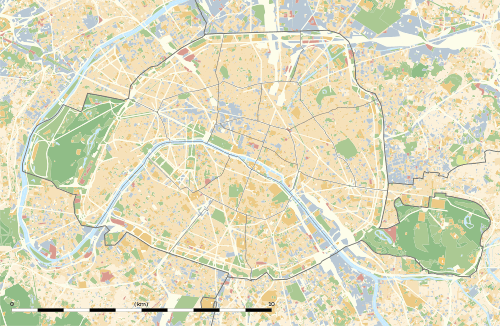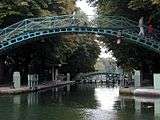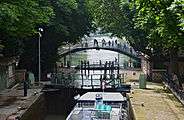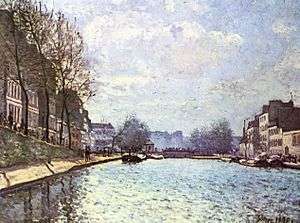Canal Saint-Martin
Coordinates: 48°52′30″N 2°21′48″E / 48.874892°N 2.363386°E

The Canal Saint-Martin is a 4.5 km long canal in Paris. It connects the Canal de l'Ourcq to the river Seine and runs underground between Bastille (Paris Métro) and République (Paris Métro). It is drained and cleaned every 10-15 years, uncovering tonnage of garbage and treasure alike.
History

Construction of the canal was ordered by Napoleon I in 1802, in order to create an artificial waterway for supplying Paris with fresh water to support a growing population and to help avoid diseases such as dysentery and cholera.
Gaspard de Chabrol, prefect of Paris, proposed building a canal from the Ourcq River (starting 100 km northeast of Paris). The canal was dug from 1802 to 1825, funded by a new tax on wine. The canal was also used to supply Paris with food (grain), building materials, and other goods, carried on canal boats. Two ports were created in Paris on the canal to unload the boats: the Port de l'Arsenal and the Bassin de la Villette.
By the 1960s, traffic had dwindled to a trickle and the canal narrowly escaped being filled in and paved over for a highway. Today, the canal is covered from Rue du Faubourg du Temple to the Place de la Bastille.
Geography
The entrance of the canal is a double lock near the Place de Stalingrad. Then, towards the river Seine, the canal is bordered by the Quai de Valmy on one side and the Quai de Jemmapes on the other. The canal widens at Bassin de la Villette, the largest artificial lake in Paris, and finally ends at the Seine via the Port de l'Arsenal. Along the canal is an unusual hydraulic lifting bridge, the Pont levant de la rue de Crimée.
 At the southern end of the canal; locks and northern portal of the tunnel
At the southern end of the canal; locks and northern portal of the tunnel- The Boulevard Jules-Ferry, which covers the lower end of the canal
 A typical iron bridge over the canal
A typical iron bridge over the canal The locks of the Récollets
The locks of the Récollets Afghan refugees, living under a bridge
Afghan refugees, living under a bridge
Tourism
Today, the canal is a popular destination for Parisians and tourists who watch the barges navigate the series of locks and road bridges. There are several popular restaurants and bars along it. The area is popular with students as well. It is near one of the highest natural points in Paris.
Métro Stations
The canal can be accessed from the following Paris Métro stations: Stalingrad, République, Goncourt, Jaurès, Oberkampf, Richard-Lenoir, Bastille, and Quai de la Rapée.
Canal Saint-Martin in culture
Art

The canal inspired painters such as Alfred Sisley. In the present day, many intricate works of graffiti are visible along the canal, and there is a large multimedia art space on its banks at the former municipal undertakers building at 104 rue d'Aubervilliers ('104').
Appearances in film and television
- The canal is shown in the 1938 film Hôtel du Nord, directed by Marcel Carné.[1]
- The canal was also the setting in part for Jean Vigo's film L'Atalante in 1934.
- In Les Malheurs d'Alfred (1972), Pierre Richard and Anny Duperey meet each other at the beginning of the film, thinking of committing suicide in the canal.
- The canal appears in Jean-Pierre Jeunet's famous 2001 film known in English as Amélie, in which the title character is shown enjoying one of her favourite activities: skipping stones at the locks of the canal.
Music
- Édith Piaf sings about the canal in the song "Les mômes de la cloche", written by Vincent Scotto and Decaye, music by Médinger, in 1936.
Notes
- ↑ However, the film was shot in the studios of Boulogne-Billancourt where the scenery of the canal was rebuilt by Alexandre Trauner.
External links
| Wikimedia Commons has media related to Canal Saint-Martin. |
- Blog of the Canal Saint-Martin quarter (French)
- Canal Saint-Martin map (French)
- (French)